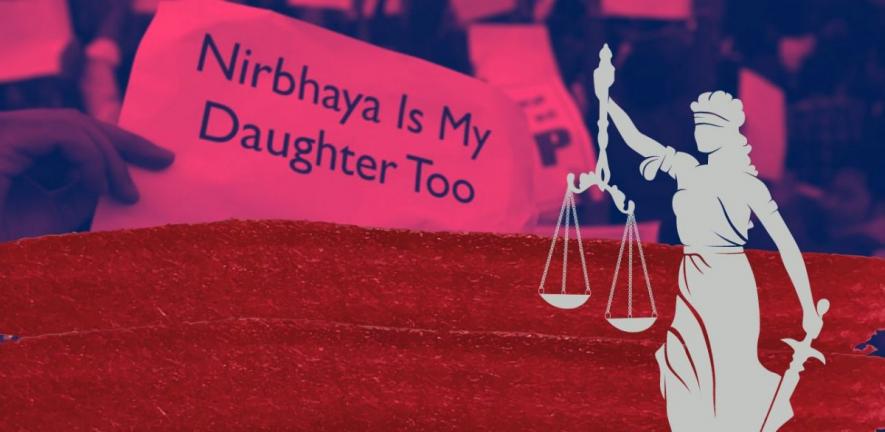Surviving Courts Post-Nirbhaya: The (im)Possibility of a Victim’s Manifesto

On the eleventh anniversary of the Nirbhaya gang rape and fatal assault, a timely assessment of whether the criminal justice system has changed for the better.
—
On this day eleven years ago, ‘Nirbhaya’ was gang raped and fatally assaulted on a bus in Delhi. The assault shook India and led to widespread protests that resulted in calls for major reforms in the criminal justice system of the country.
The State actively jumped into action by constituting a committee on December 23, 2022, to be led by a retired Supreme Court Chief Justice, J.S. Verma, to recommend amendments to criminal laws.
The committee exercised a democratic process of publicly consulting all major stakeholders and submitted a report on January 23, 2023, which justifiably went far beyond the narrow scope of its initial terms of reference, which was to “provide for quicker trial and enhanced punishment for criminals accused of committing sexual assault against women”.
It recognised that rape was an expression of power, expanded the narrow definition of rape, directed discontinuation of two-finger tests, introduced new offences such as stalking, voyeurism, sexual harassment, acid attack, etc., recommended police and educational reforms, and directed the adoption of mechanisms for reforms in the management of cases related to crimes against women.
It also signaled, though not for the first time, a promise of a shift towards a victim-centric approach, even if on paper, in institutional mechanisms for gender-based violence.
A history of eleventh-hour measures
Historically, the Indian State has constantly demonstrated a series of knee-jerk responses in the matter of rape law reform. Instead of reforming the twin core of the criminal justice system, namely, police investigation and prosecution, that has perpetuated the cycle of double victimisation for victims seeking justice, the State has periodically resorted to responding to violent crimes of sexual offence by token gestures of rape law reform like enhancing punishment and making ‘strict’ laws, even though empirical data has revealed that there is no correlation between stricter punishment and lesser sexual offence, or better chances of conviction.
The State actively jumped into action by constituting a committee on December 23, 2022, to be led by a retired Supreme Court Chief Justice, J.S. Verma, to recommend amendments to criminal laws.
Alternatively, the State has offered impossible solutions such as setting up special courts or fast-track courts with no infrastructural support; or adopting protectionist and paternalistic solutions such as surveillance and restrictions on women’s movement.
Post Nirbhaya, while the legislature stepped in a hurry and passed the Criminal Law Amendment Act, 2013, adapting some recommendations, but ignoring the more significant, potentially paradigm-altering, ones, a cursory look at some of the changes in law will generally indicate that in the registers of the law at least, some safeguards were drawn up for the victim in the criminal justice system, though not for the first time.
The executive and the judiciary have also drawn up piecemeal guidelines and practice directives in tandem. The backlash to feminist legal gains has also followed, making this decade an interesting scrutiny period for sociolegal scholars.
Ten years after post-Nirbhaya reforms, questions galore?
Ten years have now passed for one to be able to assess modestly if the position of the victim has in practice undergone any change. Can the victim fearlessly go and register a complaint as a first information report (FIR) online, as recommended by the Verma Committee?
Can she fearlessly go to the local police station and promptly have her complaint registered instead of being told, zero FIR notwithstanding, that she needs to go to the jurisdictional police station miles away to register her complaint?
If she manages to go to the jurisdictional police station, will her complaint be registered as an FIR or will she now be informed that she was too late to arrive, and be asked intrusive questions about what she was wearing, who she was with, and what business she had, not being confined indoors after sunset like the good or ideal victim?
Historically, the Indian State has constantly demonstrated a series of knee-jerk responses in the matter of rape law reform.
What happens when she goes for her medical examination? Will medical professionals not perform two-finger tests anymore, since the same has been outlawed or will they still write ‘habituated to sexual intercourse’ even though the law does not medicalise lack of consent?
What happens in the post-Nirbhaya period when, after much difficulty, the FIR is finally registered by the police? Is the investigation conducted properly? Is the chargesheet being filed on time? Are the charges being framed on time without unnecessary delay? How is the trial being conducted? Are directions, statutory and otherwise, regarding trials of a sexual offence, from in-camera trials to other directives for a recording of evidence of vulnerable witnesses being followed properly?
Is the victim being allowed to participate? Is the prosecution cooperating with the victim or her legal representative? Have defence counsels been made aware of victims’ rights? Is the trial judge a mute spectator during the trial or an active interlocutor as is expected of them?
Courtroom ethnography reveals that the victim is still punished at every stage of the trial in any proceeding of sexual violence, from prosecution of rape under the Indian Penal Code, 1860 (IPC), to the prosecution of a sexual offence against children under the Protection of Children from Sexual Offences (POCSO) Act, 2012, to the myriad web of penal offences that are articulated in texts of substantive laws, from stalking, voyeurism, sexual harassment, acid attack, cruelty, outraging modesty to dowry death.
For a figure that is so central to the making of substantive gender-based offences, it is strange that she remains a perpetual outsider to the system of criminal justice administration.
What does a victim’s ‘jurisprudence’ look like when she encounters the institutional amnesia of post-Nirbhaya safeguards from investigation to prosecution in the courtroom?
What has changed?
Any serious student of law will know that jurisprudence is not generated by appellate courts and statutes alone. Briefs or petitioners, arguments put forth by defence advocates, are as much responsible for the creation and sustenance of a courtroom culture (‘minor jurisprudence’, to borrow from Peter Goodrich) that generates a jurisprudence of survival for the victims.
A rape survivor who battled the system for over fifteen years to finally see a conviction had in all her wisdom shared with me once in jest, that a victim has to survive the system first to be anointed a survivor.
Is the trial judge a mute spectator during the trial or an active interlocutor as is expected of them?
Now and then, there have been scattered institutional attempts to make courtroom practices responsive to victims, and occasional guidelines and practice directives have been generated for the said purposes. Several high courts have by now drawn up detailed guidelines for recording evidence of vulnerable witnesses, in terms of the directions of the Supreme Court in Smruti Tukaram Badade versus State of Maharashtra & Anr where the court expanded the definition of vulnerable witness to include victims of sexual offence within its ambit.
Similarly, there have been several practice directives, for the treatment of POCSO Act victims, several standard operating procedures for the investigation of rape and child sexual offence, and medicolegal procedures have been drawn up.
Still, none of them have been able to usher in any wide-ranging institutional change of practice or any substantive diversion from the status quo, which is, the perpetuation of a hostile system as opposed to heralding a victim-centric jurisprudence.
In 2008, four years before Nirbhaya, the Criminal Procedure Code (CrPC), 1973 was amended to insert the definition of ‘victim’ as “a person who has suffered any loss or injury caused by reason of the act or omission for which the accused person has been charged” and the definition included “his or her guardian or legal heir” as well.
Fourteen years and several articulations about victim’s rights later, in Jagjeet Singh versus Ashish Mishra, a three-judge Bench of the Supreme Court categorically reaffirmed that “it cannot be gainsaid that the right of a victim under the amended CrPC are substantive, enforceable and are another facet of human rights. The victim’s right, therefore, cannot be termed or construed restrictively like a brutum fulmen.”
The court reiterated that “these rights are totally independent, incomparable and are not accessory or auxiliary to those of the State under the CrPC. The presence of ‘State’ in the proceedings, therefore, does not tantamount to according a hearing to a ‘victim’ of the crime.”
The slip between the cup and the lip
Yet, one sees from experience that courts routinely conflate the victim with the de facto complainant (where the victim is not the de facto complainant as is quite common in cases where charges are under the POCSO Act and trafficking) and refuse to offer a space for the victim to participate in her trial, in abject denial of Section 40 and Rule 4 of the POCSO Act which mandate not only the right of the victim to appoint her legal counsel but also her right to be informed of every stage of the proceeding by the investigating officer, so that she can meaningfully participate in the proceedings.
Section 228A of the IPC explicitly prohibits the disclosure of the identity of the victim of certain offences, including sexual assault.
For these legislative guarantees to be rendered to the victim, an active information dissemination system needs to be in place. For the presence of the victim’s informant or family and for utilising the Section 40 provision of availing a legal representative, information relating to the time and nature of proceedings, specifically proceedings that are not a part of the natural course the court dates (for instance the moving of a bail application by way of a ‘put up’ petition or filing and moving bail applications before vacation Benches).
In most cases, it is within the knowledge of the investigating officer who routinely fails to convey such information to the victim. Even if the information is communicated upon the direction of the court, it is communicated only to the de facto complainant, who is, in such cases mostly a distinct entity from the victim.
This lapse in communication deprives the victim of the right to meaningfully participate in proceedings that have been held by courts to be a statutory guarantee. In addition, it manifestly violates the requirement under the POCSO Rules to keep the child victim and the guardians duly informed of such proceedings being moved in a timely fashion.
Take again, for example, the persistent articulations, statutory as well as judicial, about the need to protect victim’s identity in cases of sexual violence and under the POCSO Act. Section 228A of the IPC explicitly prohibits the disclosure of the identity of the victim of certain offences, including sexual assault.
It imposes a legal obligation on anyone involved in the judicial process, including law enforcement officials, legal practitioners and the media, to refrain from revealing the name, address or any other details that could lead to the identification of the survivor.
Violation of this provision is punishable with imprisonment and a fine, pointing to the gravity with which the law regards the confidentiality of victims. Specifically for offences under the POCSO Act, Section 23 seeks to prohibit the reporting or commentary on a child in any media or photographic facilities in a way where the divulging of details will lead to the potential identification of the child victim.
Section 23 seeks to prohibit the reporting or commentary on a child in any media or photographic facilities in a way where the divulging of details will lead to the potential identification of the child victim.
On a similar limb, Sections 24(5) and 33(7) of the Act place the onus on the police officer recording the child’s statement and the special POCSO court to ensure that the identity is safeguarded from public media.
Nipun Saxena versus Union of India set forth the rule of using sealed covers for communication and court filings to be implemented to avoid adverse disclosures of such identity. While the court acknowledged situations whereby the identity would be exposed, by default practice they emphasised the need to prevent lapses on the part of law enforcement agencies and courts in doing so.
Yet, in practice, it is not at all uncommon for the victim’s identity or her family member’s identity to be disclosed in a cavalier and lackadaisical fashion by various stakeholders of the system, from investigating officers to medical professionals, to witness statements which are made part of court records, hence publicly available, without redacting such information or putting the same in a sealed cover.
Courtroom ethnography and victim testimonies also reveal that in-camera trials are hardly conducted following proper procedure, with various visitors to the courtroom, including the family members of the accused persons, actively roaming around.
Poor infrastructure and lack of resources of trial courts make it impossible for them to construct practical courtroom practices and aids responsive to such victims of sexual violence, even when they have the best of intentions.
Dilli dur ast
Outside Delhi, very few states have set up effective and functioning vulnerable witness deposition centres in accordance with the Model Guidelines for Vulnerable Witnesses Deposition Centres and the direction of the Supreme Court in Smruti Tukaram Badade.
The figure of the victim in the criminal justice system, therefore, continues to languish in the periphery. Expectedly, where her other identities of marginalisation such as disability, caste and being part of a religious minority intersect, her vulnerabilities also intensify.
Poor infrastructure and lack of resources in trial courts make it impossible for them to construct practical courtroom practices and aids responsive to such victims of sexual violence, even when they have the best of intentions.
From public institutions such as courtrooms, which are notoriously inaccessible to persons with disabilities, physically inaccessible courthouses, lack of sign language interpreters, unaware judicial officers refusing to provide support persons, to defence advocates actively opposing support structures for the victim, the system actively bends away from the disabled victim.
In some states, as Jinee Lokaneeta’s work has shown, trial courts and prosecution insist on pseudo-truth technologies such as narco-analysis to be used even though they had no evidentiary value, only to dissuade Dalit women from testifying, the institutional assumption being that Dalit women are habitual liars.
Courtroom culture and practices continue to create artificial categories of good or ideal victim and the Other, based on stereotypical assumptions of their conduct and identity— individual as well as community.
The recently released Supreme Court Handbook Combatting Gender Stereotypes may be one step in the right direction, along with the directions in Smruti Tukaram Badade to set up Vulnerable Witnesses Deposition Centres, and myriad other directions and guidelines, but one wonders, without rigorous institutional reform, which includes sustained training of all actors in the courtroom, from the Bench clerk, the judicial officer, the prosecution, investigating officer, to even the defence advocates, how far can such handbooks and directives go?
Without the political will to feminise our juridical structures and tools of justice, no emancipatory politics of dignity is possible, let alone a demand for equal sexual citizenship in courts that could transform a victim into a survivor.
Institutional reform is a political project. Without the political will to feminise our juridical structures and tools of justice, no emancipatory politics of dignity is possible, let alone a demand for equal sexual citizenship in courts that could transform a victim into a survivor.
One wonders, in the registers of public memory, ten years since the Justice Verma Committee recommendations, and eleven years since what triggered it, that is the Nirbhaya case, has there been any material change to the figure of the victim in the courts of law?
The author thanks Trisha Garimela for research support.
Jhuma Sen is an advocate practising before the Calcutta High Court and the Supreme Court.
Get the latest reports & analysis with people's perspective on Protests, movements & deep analytical videos, discussions of the current affairs in your Telegram app. Subscribe to NewsClick's Telegram channel & get Real-Time updates on stories, as they get published on our website.
























